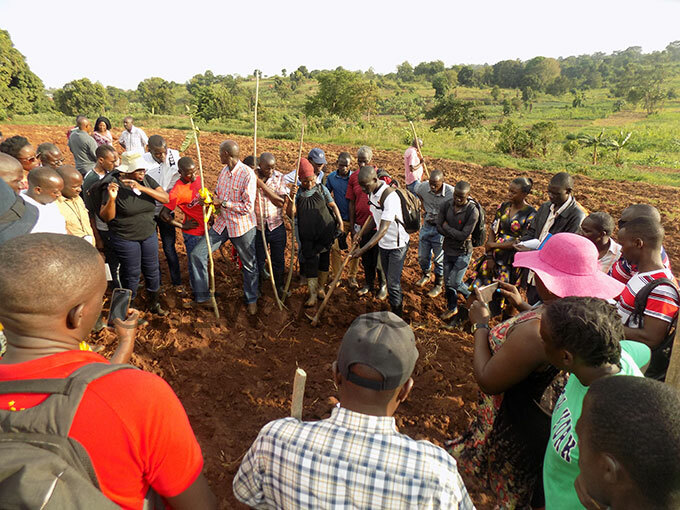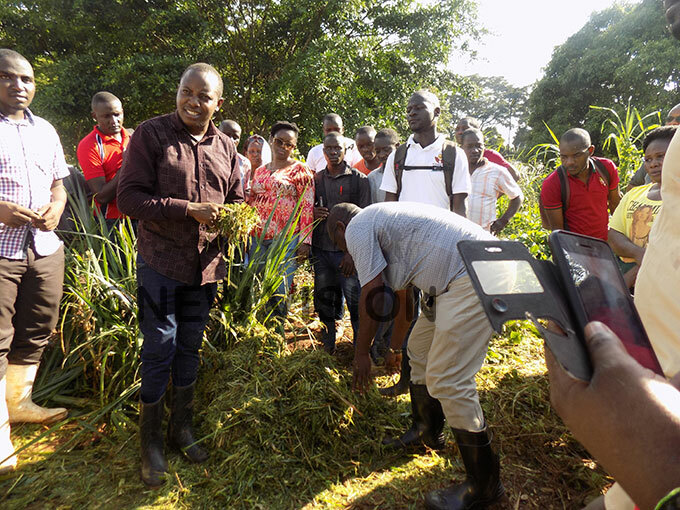For more milk, grow pastures for your cows
Pastures have high ability to colonize the places where they are grown. They possess high levels of required nutrients that are needed by animals for quick maturity
AGRICULTURE
On Saturday April 13, over 200 farmers gathered at Makerere University Agricultural Research Institute, Kabanyoro to learn about better feeding methods for dairy cattle.
The training was conducted by Brian Natwijuka and Allan Patrick Iga. Below are some of the issues discussed.
Importance of pastures
Pasture management should be thought of as grass farming. Think of the grasses as your crop, while you use animals to harvest.
Pastures should be looked at as crops which need care, need weeding, well prepared seedbed and fertile soils. Once you embrace this, then you will enjoy farming.
Grasses need Nitrogen fertilizer to grow vegetative and increased production, so we normally advise to mix grasses with Legumes that add nitrogen to improve the quality of the grass and production.
Over the years research has been made and new pastures and management systems have been developed to handle challenges mostly lack of enough feeds for animals during dry seasons and improving production by providing the required nutrients.
Some are drought resistant solving the biggest problem of lack of enough feeds during dry seasons.
They can easily be ensiled and stored for future use. They are highly palatable. Value can easily be added (processed into feeds)
Why should farmers grow pastures?
Pastures have high ability to colonize the places where they are grown. They possess high levels of required nutrients that are needed by animals for quick maturity, increased production, good health and quality products.
They have high regeneration potential (after grazing), improve soil fertility by nitrogen fixation .
There are several pastures that can easily help dairy farmers yield more. These include Chloris Gayana, Brachiaria Mulato and the improved napier varieties. Others that are however not main feeds are are Lab lab, desmodium and calliandra
Chloris Gayana (Rhodes grass)
Crude protein: 9.5-16.4%dm
Crude fibre: 35.5-40.4%dm
Calcium: 3.1-4.5g\kg
Digestibility;: 86.4-92.8%dm
Yields 20-27tonnes per acre per year. It is also drought resistant with a very high regeneration capacity! Carrying capacity is two animals per acre.
It has high digestibility and palatability making it very useful to animals not forgetting the high nutrition quality.
When mixed with a legume, it`s nutrient content increases and since legumes fix nitrogen, the production is high, nutrients are always high when young 3-5weeks and it reduces as it grows, always allow animals feed it or cut it down for Hay. Establishment and management
Chloris requires rainfall of 500-1500 mm per year with fertile soils and a well-prepared seedbed is required for:
Creating a favourable environment in which seeds will germinate, emerge and grow. If vegetative material is being used, it is good for starting new roots and shoots.
If the land has some kind of a slope, work across the slope.
Avoid an unnecessarily fine seedbed, which may render the soil highly susceptible to water and wind erosion. If the soils are shallow and likely to be highly susceptible to erosion, leave strips of undisturbed soil across the slope to reduce the potential for soil erosion.

Sowing from seed
Rhodes grass and legume seeds should be mixed together before planting. The mixed seed can be sown by broadcasting or sowing in rows. Broadcasting is quicker and cheaper.
For broadcasting, seed is best mixed with sawdust or sand; and for drilling, it flows more readily if pelleted. Row planting gives better establishment and weeding is easier. Spacing for row-planted seed is 30 cm between rows.
Planted seed must be lightly covered with soil using a rake or leafless branch to ensure good seed and soil contact and for protection from birds and being washed away by rain.
Rhodes grass responds to phosphorus in poorer soils, and gives a higher yield and crude protein response of up to 100 kg/ha of nitrogen. Contact your extension staff for the correct fertilizer rates.
Vegetative planting
Vegetative planting is necessary where seed is not constantly available and/or are very expensive.
Vegetatively planted pasture takes longer to establish. The method is more labour intensive. The older stems with new root growth are the best planting materials. Planting can be done by hand using a hoe.
Runners, splits or cuttings can be used. Planting should be in a moist seedbed and the runner should be covered with soil. Apply Nitrogen fertiliser at a rate of 50kgs per acre to improve yields.
Weeding
The pasture should be kept weed-free to avoid competition between the planted pasture and weeds. Some weeds are poisonous. These include Lantana camara (tick berry or sage brush), Solanum incanum (Sodom's apple) and Phytolaca dodecandra. Continuous cutting of the plants and digging out of roots of all types of weeds will reduce their population and weaken the plants until they are eliminated.
Weeding of pastures is a continuous activity to which a farmer should pay particular attention. Good grazing management will control weeds in a pasture.
Briacharia Mulato (signal Grass)
Briacharia Mulato is an emerging source of grass for cattle keepers. Mulato combines high protein content (13%), good grass yield, drought resistance and adaptation to infertile soils.
These mulato species have also shown good agronomic characteristics in areas such as Uganda and Rwanda. mulato can, therefore, be used to supplement napier grass fodder, especially during the long drought when napier grass productivity is affected by napier stunt disease.
Establishment, management and utilisation
Brachiaria requires well-drained soils of medium to high fertility with pH 4.5-8.0, but can grow in less fertile acidic soils. You can know the PH of your soils by carrying out a soil test. A sample costs sh30,000 at Kawanda.
Mulato can be established from seed planted into a well-prepared seedbed at 6-10 kg of seed per hectare with a spacing of 1 x 1 m. Brachiaria can also be established vegetatively from cuttings and splits. The rooted stems are planted at a spacing of 1 m x 1 m.
The grass responds well to additional nitrogen fertiliser from organic and inorganic fertilisers. It establishes rapidly, achieving 85% ground cover at two months after seeding.
The nutritive quality of Brachiaria grass is improved when inter-cropped with forage legumes such as Centrosemapubecens and Clitoriaternatea. Weed control is important in improving fodder yield and quality.
The grass can be lightly grazed after 3-4 months or used for cut-and-carry production system. Mulato makes good quality hay; is more palatable and easier to conserve than other grasses.

What are the yields per acre?
Dry matter yields of 15-25 tonnes/ha per year. The forage legume acts as a cover crop to control weeds and conserve soil moisture during the dry periods, apart from the possibility of augmenting nitrogen supplies to the grass component through symbiotic nitrogen fixation.
Results from this study show that the currently, recommended acreage of 0.5ha of a mixture of napier grass and forage legumes for dairy cow under stall-feeding system cannot sustain an economically producing dairy cow and its calf for a full year.
Introducing 0.5ha of a mixture of Brachiaria and forage legumes on farms previously dependent on 0.5ha of a mixture of napier grass and forage legumes, provides year-round feed supply.
Nutritive value
The average protein content of Mulato ranges between 9 and 17% while that of elephant grass ranges between 7 and 12%, depending on the variety.
Napier grass
Dry matter 16.5 to 24.0 percent, crude protein 9.9 to 15.5%, crude fiber 26.5 to 33.6 percent, crude fat 2.4 to 4.5 percent. Napier grass {Pennisetum purpureum), also known as elephant grass and Merker grass, is a rank-growing perennial which is being used extensively for rotational pastures as silage.
It can be used to make silage, or it can be cut fresh and fed to animals fresh, it grows very first and has a high regeneration capacity especially in the rainy season.
It is the highest foliage produce( fresh) however it has been disturbed by the Napier stunt disease which reduces production and to solve this problem, the resistant varieties have been developed like (kakamega 1)
It is production is high and it quality increases when mixed with Legumes. Advantages of Napier grass fodder
• Napier grass is easy to propagate and manage within a wide ecological range
• It produces high dry matter fodder yield (20-35 tons per ha per year) compared to other forage grasses
• It has good palatability and good nutrient content (10-12% crude protein) at early stages
• The grass produces very good silage when harvested at the right stage of growth
• It is widely used for soil and water conservation in hilly slope areas and can serve as a wind-breaks
• It is an important tool in the integrated management of striga weed and stem borers of maize and sorghum due to its importance as a trap crop for these weeds and pests.
• Many farmers without animals produce Napier grass fodder (fresh or conserved) or planting materials (cuttings) for sale to dairy farmers
• The grass and stems are widely used in construction of houses.
Limitations to use of Napier grass fodder
• Not suitable for direct grazing and hay production
• Susceptible to various pests and diseases such as head smut and stunt diseases
• Takes a lot of nutrients from the soil - requires a lot of manure/fertilizer to get high yields
Establishment of Napier grass
Napier grass can be grown at altitudes ranging from sea level to 2,000 meters above sea level. The grass does best in high rainfall areas, over 1500 mm per year. It grows best in deep, fertile, well-draining soils. It is drought tolerant and can be used as dry season reserve in dry areas.
Whether root splits or cuttings/canes are used, they should be sufficiently mature to tiller well and produce tall and high yielding forage plants. Cane planting materials should be obtained from plants about to flower where the stems are still green and from fields with no disease infection.
Lab-lab
15-17% whole plant crude protein, 25% for leaves. This protein% is higher than the recommended crude protein for ruminant growth of 11%.It is the legume with the highest biomass production, it grows very first , it is very palatable to animals , it is not resistant to drought and should not be fed fresh to animals but rather it should be wilted under shed to avoid blot.
When do you graze on new pasture field?
Grazing should not be allowed until the grasses are well established and have developed a strong root system. Uncontrolled early grazing may lead to plants being pulled out of the soil and the soil may be compacted by the livestock.
The first grazing, which should be light, is done 2 to 3 months after the seed has germinated. Light grazing allows the grass to develop more shoots (tillering) so that the legumes are not shaded by the grass and grow well.
How many cows do you allow into a pasture field per acre?
This refers to how many animals are allowed into a given area of pasture and at any given time. This is the stocking rate.
The stocking rate should be flexible such that the number of animals kept are increased or lowered to match pasture availability.
On average, two to three times a week, with 10 animals per acre. High quality grass/legume pasture should not be allowed to become too mature.
Grazing should not be lower than 20 to 30 cm high. Conservation (hay or silage) of excess pasture produced during the growing period, or the purchase of feed or sale of animals, will all lead to efficient use of pastures.
Brian Natwijuka is a pasture/forage expert working with Makerere University Agricultural Research Institute, Kabanyoro to multiply pastures while Alla Patrick Iga is a professional Agriculturist.